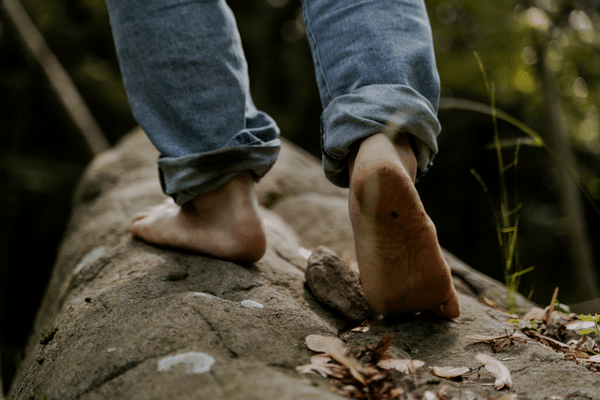
Do you ever feel like your feet need a break? Walking barefoot can be a great way to give them just that. Not only is it a great way to relieve stress and feel more connected to your environment, but according to science, it can also help improve your posture, strengthen your muscles, and reduce stress. In this article, we will explore the science of walking barefoot and provide tips on how to get started safely. So, if you want to reap the benefits of walking barefoot, keep reading!
The Benefits of Walking Barefoot
Walking barefoot is an easy and convenient way to reap the many health benefits associated with going shoeless. Studies have shown that it can help improve your balance, increase flexibility, and reduce anxiety and stress. Scientists have also suggested that it may have a positive effect on the immune system and even improve your mood. Walking barefoot can also help strengthen the feet and lower the risk of developing chronic foot pain. While it may not be suitable for every setting, walking barefoot can be a great way to connect with nature and obtain some of the amazing benefits it has to offer.
Improved Posture
Walking barefoot is a great way to help improve your posture. That’s because the lack of arch support provided by shoes encourages you to stand and walk more naturally, leading to better posture. By allowing your foot to move freely, your lower back and hips are better aligned and your core is better engaged. This can help prevent pain and even improve balance. Plus, when you take your shoes off, you’re free to move and use your feet instinctively, leading to a more natural gait that can even help you prevent injury. So slip off those shoes, and start enjoying the benefits of more natural walking – it might just be the key to better posture.
Strengthened Muscles
When you walk barefoot, you’re strengthening muscles that you might otherwise not use when wearing shoes. Barefoot walking causes you to use the muscles in your feet and lower legs that provide stability and balance, to be engaged. These muscles can become stronger over time and result in increased stability, strength, or agility. Additionally, movements that would otherwise be uncomfortable while shoes are worn may become more comfortable and natural when you go barefoot. The science behind walking barefoot is real, and the benefits could be far-reaching!
Reduced Stress
Walking barefoot can be a great way to reduce stress, both mentally and physically. Research has found that the act of walking barefoot on natural surfaces can reduce cortisol levels, the hormone related to stress. Additionally, being barefoot can also help to increase serotonin levels, which can help to improve mood and overall wellbeing. Walking barefoot can also help to reduce anxiety and create a calming effect on the body. For those looking to reduce their stress levels, walking barefoot is an easy and effective tool to include in a wellness routine.
Tips For Walking Barefoot
How to Start
Ready to walk barefoot? Getting started is easier than you think, and you can reap the health benefits right away. Take a slow, leisurely stroll on the grass, and don’t worry if you can’t go far – even a five minute walk is enough to start feeling the effects. Start with a grassy area to give your feet some cushion, then gradually increase the terrain you walk on. Once you’re comfortable walking barefoot on flat ground, move onto rocks and pebbles to get an energy boost. Enjoy the feeling of the earth beneath your feet, and as your body gets used to walking barefoot, you’ll be able to go farther and reap even more health benefits. So get started, and start feeling the benefits of walking barefoot today!
Safety Considerations
If you are considering taking a barefoot walk, it is important to keep safety in mind. Chances are you’ll be walking on surfaces you’re not used to, like gravel, sharp rocks or even glass. Always be aware of your environment and make sure the ground you are walking on is free from sharp objects, broken glass, and other hazards. If you’re walking on a surface that’s unfamiliar to you and you’re not wearing any shoes, it’s a good idea to take extra caution. Additionally, it’s a good idea to limit the amount of time you spend walking barefoot and to keep an eye out for any potential hazards. Finally, before embarking on your journey, make sure to stretch and warm up your body and feet to avoid any potential injuries while walking with no shoes.
Surfaces to Avoid
Walking barefoot is an easy and enjoyable way to reap the health and wellness benefits associated with grounding. However, it’s important to be aware of which surfaces you should avoid. There are specific surfaces that can cause injury or infection, so take care to keep away from these. These include grass that has been treated with herbicides, pesticides, and other chemicals; surfaces with sharp objects that could puncture the skin; concrete and asphalt that has been treated with chemicals; and surfaces that may have been contaminated with animal waste or other bacteria. All in all, use your common sense and keep away from anything that could cause harm.
Conclusion
In conclusion, walking barefoot can offer a number of positive benefits for your physical, mental, and spiritual well-being. By improving your posture, strengthening your muscles and relieving stress, walking barefoot can help you lead a healthier, happier life. Additionally, there are many tips and safety considerations to take into account when beginning a barefoot journey. Though there are certain surfaces that should be avoided when walking barefoot, there are still plenty of ways to safely and comfortably enjoy the benefits of barefoot walking. So, why not give it a try? Feel the ground beneath your feet, and reap the benefits of walking barefoot today!
Read More:
Don’t Expect Toxic People To Admit Their Mistakes



